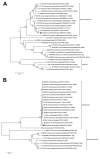Novel Eurasian highly pathogenic avian influenza A H5 viruses in wild birds, Washington, USA, 2014
- PMID: 25898265
- PMCID: PMC4412248
- DOI: 10.3201/eid2105.142020
Novel Eurasian highly pathogenic avian influenza A H5 viruses in wild birds, Washington, USA, 2014
Abstract
Novel Eurasian lineage avian influenza A(H5N8) virus has spread rapidly and globally since January 2014. In December 2014, H5N8 and reassortant H5N2 viruses were detected in wild birds in Washington, USA, and subsequently in backyard birds. When they infect commercial poultry, these highly pathogenic viruses pose substantial trade issues.
Keywords: A(H5N2); A(H5N8); H5N2; H5N8; HPAI; United States; highly pathogenic avian influenza virus; influenza; intercontinental transmission; reassortment; viruses; wild birds.
Figures


Similar articles
-
Lessons from the Largest Epidemic of Avian Influenza Viruses in Taiwan, 2015.Avian Dis. 2016 May;60(1 Suppl):156-71. doi: 10.1637/11168-051915-Reg. Avian Dis. 2016. PMID: 27309051
-
Transmission Dynamics of Highly Pathogenic Avian Influenza Virus A(H5Nx) Clade 2.3.4.4, North America, 2014-2015.Emerg Infect Dis. 2018 Oct;24(10):1840-1848. doi: 10.3201/eid2410.171891. Emerg Infect Dis. 2018. PMID: 30226167 Free PMC article.
-
Lack of chicken adaptation of newly emergent Eurasian H5N8 and reassortant H5N2 high pathogenicity avian influenza viruses in the U.S. is consistent with restricted poultry outbreaks in the Pacific flyway during 2014-2015.Virology. 2016 Jul;494:190-7. doi: 10.1016/j.virol.2016.04.019. Epub 2016 Apr 26. Virology. 2016. PMID: 27110710
-
Evolution, global spread, and pathogenicity of highly pathogenic avian influenza H5Nx clade 2.3.4.4.J Vet Sci. 2017 Aug 31;18(S1):269-280. doi: 10.4142/jvs.2017.18.S1.269. J Vet Sci. 2017. PMID: 28859267 Free PMC article. Review.
-
Intracontinental and intercontinental dissemination of Asian H5 highly pathogenic avian influenza virus (clade 2.3.4.4) in the winter of 2014-2015.Rev Med Virol. 2015 Nov;25(6):388-405. doi: 10.1002/rmv.1857. Epub 2015 Oct 13. Rev Med Virol. 2015. PMID: 26458727 Review.
Cited by
-
Recombinant hemagglutinin glycoproteins provide insight into binding to host cells by H5 influenza viruses in wild and domestic birds.Virology. 2020 Nov;550:8-20. doi: 10.1016/j.virol.2020.08.001. Epub 2020 Aug 12. Virology. 2020. PMID: 32861143 Free PMC article.
-
Widespread detection of highly pathogenic H5 influenza viruses in wild birds from the Pacific Flyway of the United States.Sci Rep. 2016 Jul 6;6:28980. doi: 10.1038/srep28980. Sci Rep. 2016. PMID: 27381241 Free PMC article.
-
Novel Highly Pathogenic Avian A(H5N2) and A(H5N8) Influenza Viruses of Clade 2.3.4.4 from North America Have Limited Capacity for Replication and Transmission in Mammals.mSphere. 2016 Apr 6;1(2):e00003-16. doi: 10.1128/mSphere.00003-16. eCollection 2016 Mar-Apr. mSphere. 2016. PMID: 27303732 Free PMC article.
-
Semi-Scavenging Poultry as Carriers of Avian Influenza Genes.Life (Basel). 2022 Feb 21;12(2):320. doi: 10.3390/life12020320. Life (Basel). 2022. PMID: 35207607 Free PMC article.
-
Hemagglutinin Stalk- and Neuraminidase-Specific Monoclonal Antibodies Protect against Lethal H10N8 Influenza Virus Infection in Mice.J Virol. 2015 Oct 28;90(2):851-61. doi: 10.1128/JVI.02275-15. Print 2016 Jan 15. J Virol. 2015. PMID: 26512088 Free PMC article.
References
-
- World Organisation for Animal Health. Summary of immediate notifications and follow-ups–2014. Highly pathogenic avian influenza [cited 2014 Dec 14]. http://www.oie.int/wahis_2/public/wahid.php/Diseaseinformation/Immsummary
Publication types
MeSH terms
LinkOut - more resources
Full Text Sources
Other Literature Sources
Medical

